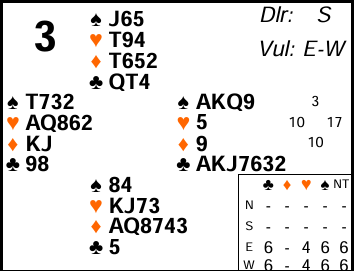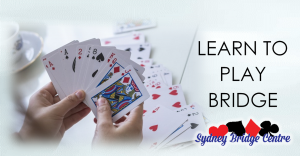City and Canada Bay – Thursday Morning 13th February 2025.

A few weeks ago I wrote about reaching game after the opponents open. Board 3 last week had a slam available for East West – usually after the opponents had opened! Very few pairs managed to find it though – let’s have a look.
Most South’s these days will open 1♦ despite the 10 points. I certainly would with the 64 shape – plus it’s a suit you are happy for partner to lead. Many Wests will then overcall 1♥ (again it’s a suit you are happy for partner to lead). North will most likely pass. Even if partner’s 1♦ shows at least 4, it looks quite brave to start pre-empting on a 4333 3 count (although the vulnerability does make it attractive). East has a really big hand and has to decide what to do. His hand is good in terms of points but the real power is his distribution – if partner has a fit for either suit (even with a very weak hand) his hand becomes enormous. One of the most fundamental things to learn in bridge as you get more experienced is that shape beats points every time!
So how should East bid? Normally he can just start with a simple 2♣ forcing bid (but see advanced section for an alternative treatment). South said enough opening so will pass and now West has a tricky call. A lot will rest on which of his possible bids show extra values.
He could bid 2♠ but some pairs play that like it would be after an opening (i.e. 1♥ – 2♣) where it shows extra values. If that is the case (it’s something worth established pairs discussing) then he can’t possibly do that on just 10 points. West’s only options then are 2♥ (but it’s not nice repeating a suit you have already shown 5 of) or 2NT (but you’d like longer diamonds to make a better stopper). It doesn’t much matter here because over either of those East can continue with spades at whatever level (a new suit being forcing) and now West will of course raise.
At the point West bids or raises spades what should East then do? I’d simply jump to 4NT Blackwood! Many players use Blackwood on unsuitable hands (see advanced section for more discussion on that) but this one is perfect for it because the only thing you care about is how many red aces partner has. You should have an excellent chance of establishing your clubs by ruffing in partner’s hand if necessary. Hence if partner shows no key card, you stop in 5♠, 1 key card you bid 6♠ and if he shows both I’d have a go at 7♠!
What about the play? There’s not much to it. If played by West, North will surely lead a diamond. If played by East, South might lead ♦A but he also might try a heart in the hope of finding partner with ♥Q to set up a trick before his ♦A is knocked out (that’s particularly the case if West has bid 2NT as the ♦K is now almost certainly going to be sitting over him).
If the defence have taken ♦A they can’t do anything else. Declarer can test trumps with 2 rounds and when they split 3-2 it’s easy to draw the 3rd round and cash ♣A. When both defenders follow he can play ♣K and ruff a club to set the suit up.
Note that spades is a better contract than clubs. With clubs as trumps you’d need to find the ♣Q (i.e. finesse against North here). With spades as trumps that’s not necessary because you can ruff the clubs in dummy to make them good. As is so often the case, playing in a good 4-4 fit is best. But it’s close – see advanced section for more.
Only two pairs reached 6♠ (1 in each venue) and deservedly got a top board. Final quiz – if you were East in 6♠ and you got a heart lead, you could finesse the ♥Q and then discard your singleton diamond. It’s very likely to work if South opened the bidding as he surely must have nearly all the missing 13 points. Would you try it to make 13 tricks? See advanced section for some thoughts.
Key points to note
Slams can still be bid after the opponents open. Shape beats points every time!
New suits are normally forcing (although some pairs no longer do that after their side overcalls at the 1 level).
Blackwood is suitable on hands where all you want to know is how many key cards partner has. It’s not a good idea on hands where you need to know which key cards partner has (e.g. with a void or 2/3 small in a suit).
4-4 fits are very powerful to play in.
More advanced
When responding to overcalls traditionally a new suit is forcing. These days, however, pairs are playing lighter and lighter overcalls, especially at the 1 level. That’s led to some pairs playing a new suit as highly encouraging but not forcing. That would cause East a problem here as he can’t possibly take the risk of partner passing 2♣ when he can almost make game in his own hand! His only option would be to cue the opponents suit first (note that can’t now be played as a cue raise as it’s also needed for a big forcing hand with another suit – so West can’t assume it’s a raise and go jumping around in the auction until partner has clarified what he had for his cue bid). All in all it can make the auction very messy so I’m personally not a fan of the method and prefer to just keep all new suits as forcing.
I said many players use Blackwood when they shouldn’t. The hands where Blackwood works well is when all you want to know is HOW MANY key cards partner has. This board is a perfect example. Once East finds a spade fit the only two cards he cares about are the red aces. But very often you need to know more than that – you need to know WHICH key cards partner has. Blackwood won’t tell you that. Examples where problems can arise are hands with voids or with something like 2 or 3 small in a suit. If partner’s Blackwood response means you don’t have all the key cards you are now guessing which one(s) he does have. An ace opposite your void could be useless. An ace not in a suit where you have 2 or 3 small might mean you have 2 quick losers.
A far better approach on these hands is cue bidding. Once partner cue bids a control in a suit NOW you might Blackwood. But not immediately. Blackwood is most useful as a tool to keep you out of slam if you happen to be missing two key cards. Not as a tool to enable you to bid slams!
Which suit is better to play in? Let’s look at the odds. Spades is basically a bit better than 68% (which is the odds of spades breaking 3-2). You will also be ok when they split 4-1 with singleton ♠J and you might be able to handle North having ♠Jxxx so that improves it a bit.
Clubs needs clubs 2-2 (41%) or singleton ♣Q (12.5%) or to guess to pick up Qxx with North. So overall spades is better.
Note that even if clubs were a little better you would still want to play in spades when playing matchpoints because it scores more – and that will happen most of the time. At imps, however, you’d prefer the slam with the best chance of making – the difference between 1370 and 1430 is largely irrelevant.
Finally would you finesse in 6♠ by East on a heart lead? I wouldn’t for a few reasons:
1. How many pairs do you think will have bid 6♠? Unless you think almost everyone will (unlikely unless you are playing in a very strong event) then you are going to score very well just making 6♠. It would be crazy to risk the finesse for an overtrick. It might gain you 2 or 3 matchpoints and risk losing you the whole board!
2. It’s not certain to win even with only 13 points missing. Here South opened on 10 and North did have 3 points. They could easily have been ♥K rather than ♠J and ♣Q!
3. You may still be able to make 13 tricks anyway. Win ♥A and draw trumps. Now try clubs. If they behave and the ♣Q drops you can discard both West’s diamonds on the clubs anyway. Effectively you’d end up ruffing East’s ♦9 in the West hand. This would again demonstrate the power of the 4-4 fit where a longer suit suit provides discards for losers (had clubs been trumps then spades wouldn’t provide any discards).
Julian Foster (many times NSW representative) ♣♦♥♠




